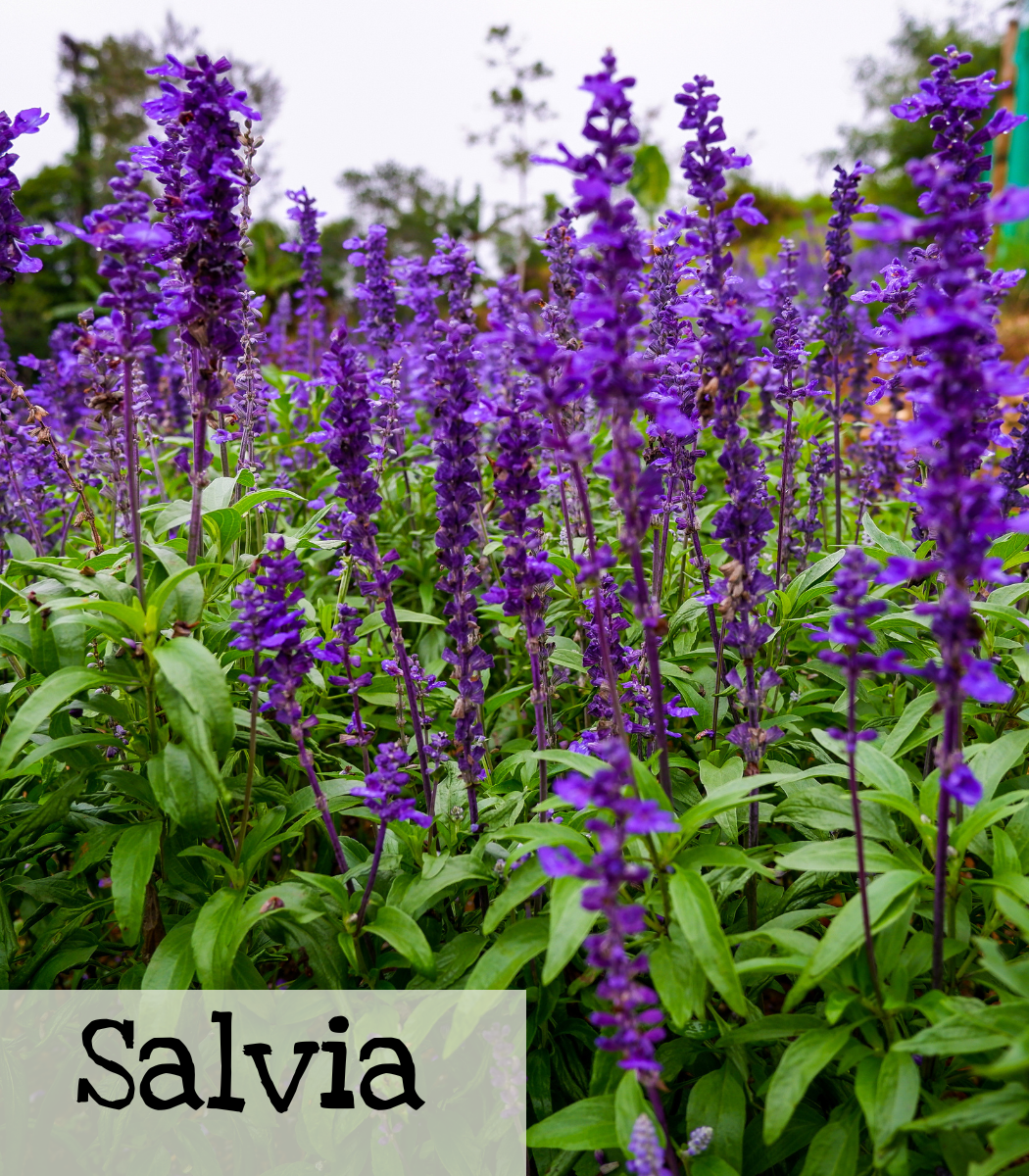
Salvia
Beloved by bees and hummingbirds, salvia is a pollinator-friendly flower. It is an ornamental sage in the mint family. The plants are quite spectacular when planted together in groups and is great for both beds and borders.
|
Sirius Blue Sage; Summer Jewels Red; Victoria |
|
Salvia farinacea: Sirius Blue Sage; Victoria Salvia coccinea: Summer Jewels Red |
|
Easy |
|
Intermediate |
|
1 year if properly stored |
|
Perennial
|
|
7-14 days |
|
None |
|
Surface Sow |
|
|
|
Seeds need light to germinate Full sun |
|
|
|
70-80 days |
|
March |
|
Yes |

Growing Tips


Sirius Blue Sage
Summer Jewels Red

Salvia coccine: (Georgia, Texas, Oklahoma, Missouri, Louisiana, Arkansas, Tennessee, Ohio, Mississippi, Alabama, Florida, South Carolina)
When to Start
Start indoors: Start indoors 6-8 weeks before the last frost date. (March for GA)
Transplant: After the danger of frost has passed and after hardening off. (May 1 for Jefferson, GA)
Direct Sow: After the danger of frost has passed. (May 1 for Jefferson, GA)
How to Grow
Start indoors 6-8 weeks before the last frost date. Salvia needs light to germinate. Surface sow by gently pressing the seeds into the seed starting mix. Place under grow lights. Or direct sow by gently pressing the seeds into the flower bed soil. You can lightly cover them to keep them from blowing away. Space or thin to 12-18 inches.
Care
Plant in well-draining soil in full sun, but will tolerate part-shade. Salvia prefers well-draining soil. The leaves a susceptible to mildew and other diseases if they get wet. Bottom water and space plants properly to provide adequate air circulation. Slugs can be a problem. See Slug Traps for tips on dealing with slugs.
Salvia blooms during the summer through fall. After the first killing frost, cut back stems to 1-2 inches above the soil. It can also benefit from a late summer pruning to help prevent legginess.
My personal experience
I’ve grown blue bedder, salvia in my front flower garden for many years now. It is a relatively low maintenance. After the first couple of years, I let nature do the watering. I don’t have a good way to water that bed unless I carry it. Who wants to do that every day? Because of this whatever is planted there has to survive on its own.
I’ll prune it back to 1-2 inches in late winter. (Jan-Feb) This way I know all the seeds have dropped and the birds have their fill. I let it reseed itself every year. This occasionally means I need to thin the plants. But I do want it to fill in to create a sea of purple!
Bumblebees seem to like this flower. I always see my bumblebee make the rounds. I’ve also seen hummingbirds, other bees, and butterflies!
Seed Saving

Isolation Distance
Insect dependent for pollination. Isolate 1/2 mile to prevent cross-pollination.
Instructions
Select healthy, robust plants free of any signs of disease or insect infestation for seeds. Seeds carry the traits of the parent plant. Choose plants that exhibit the traits you wish to preserve. Consider bloom size, color, and shape, as well as blooming time.
Allow the biggest and healthiest blooms to mature on the plant. Cover the seed head with a fine-mesh bag as soon as the flower petals shrivel and die. Use an elastic band to hold the bag in place. This prevents seeds from spilling onto the soil before harvest.
Clip the flower head from the main stem once the seeds are dry and dark. Separate plant debris from the seeds by removing the mesh bag and placing the flower head in a paper bag and shaking to loosen the seeds. Seeds settle to the bottom of the bag. Remove plant debris by hand.
Features
- Attracts pollinators
- Attracts hummingbirds
- Deer resistant
- Good cut flowers
- Easy to grow
- Good dried flowers
- Sirius Blue Sage: Heirloom. Perennial in zones 7-10. Beautiful blue flower spikes loved by hummingbirds and other pollinators. Compact 12-16 inches and drought-resistant.
- Summer Jewels Red: Heirloom. Perennial in zones 8-10. Half-inch blooms are lipstick red and reach 18 inches tall. A great bedding flower and good for borders or containers.
- Victoria: Usually grown as an annual, but it is perennial in zones 7-10. Compact plants produce violet-blue flowers from summer until frost.
Sources:
Starting & Saving Seeds by Julie Thompson-Adolf
